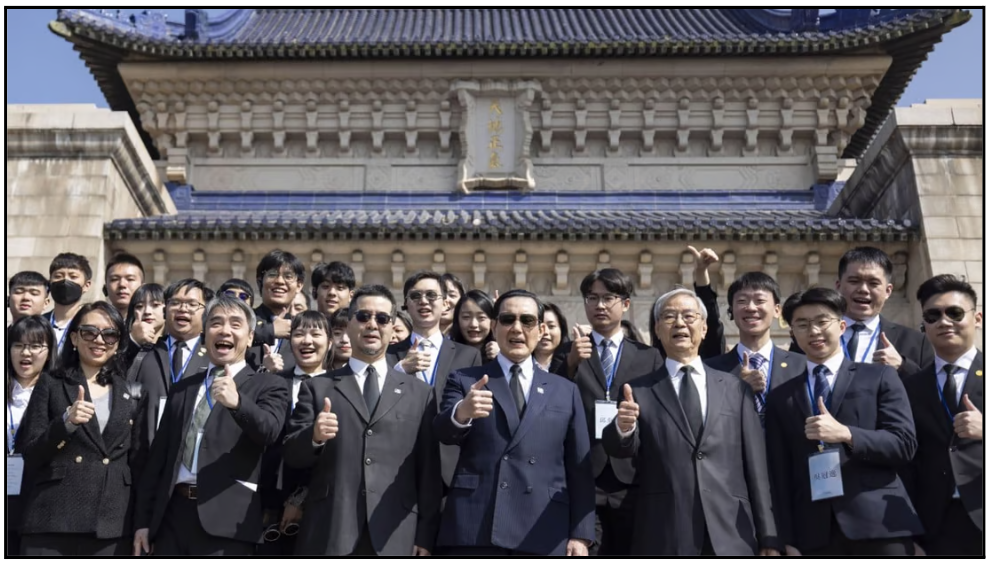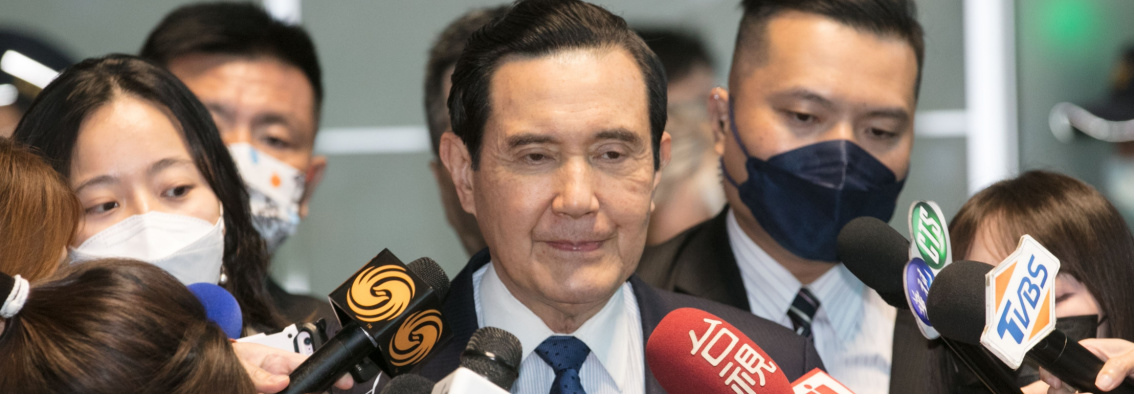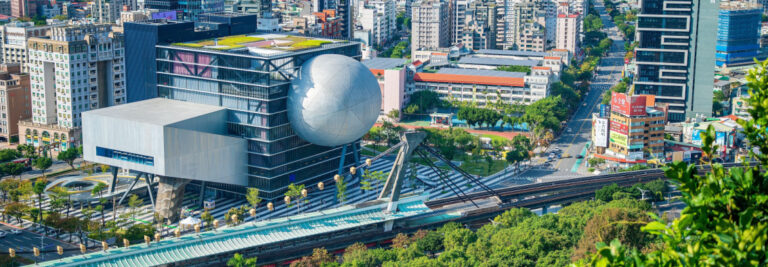It has been a busy travel year for Taiwan politicians. Much as they do before every presidential election, potential candidates have headed to the United States in recent months, always centering their visits on Washington, DC. During these trips, the candidates meet with US administration officials, members of Congress, and think tanks to convey appreciation for their support for Taiwan’s military, diplomatic, and economic security, while providing assurances that they will avoid destabilizing relations with China.
So far, Terry Gou (郭台銘), the founder of Foxconn, visited Washington in March and announced on his return to Taiwan that he will seek the Kuomintang (KMT, 中國國民黨) nomination as its presidential candidate. Ko Wen-je (柯文哲), former mayor of Taipei and founder of the Taiwan People’s Party (TPP, 台灣民眾黨), traveled to DC in April, where he also signaled his interest in being a presidential candidate. However, the Democratic Progressive Party (DPP, 民主進步黨) candidate for president, Taiwan’s current Vice President William Lai Ching-te (賴清德), will have difficulty traveling to Washington given the US policy against Taiwan’s president and vice president traveling to the United States—though there are already rumors that Lai may follow in President Tsai Ing-wen’s (蔡英文) steps by transiting through the country. This might enable him to meet quietly with US officials, perhaps from the State Department and the National Security Council, outside Washington.
The person many pundits anticipate will win the KMT nomination for president, New Taipei City Mayor Hou You-yi (侯友宜), who won reelection in November 2022, has traveled to Singapore, but has not indicated if he plans to visit the United States. Look for that to change if he does win the nomination.
KMT Elder Ma Ying-jeou Goes to China
The most striking exception to this familiar US-centric travel pattern was undertaken by someone who will not be on the ballot next January: Ma Ying-jeou (馬英九), the former two-term president of the Republic of China (2008-2016) and the dominant elder of the KMT. From March 27 to April 7 Ma visited China, stopping in Nanjing, Changsha, Xiangtan, Wuhan, and Shanghai. Ma stated that he wanted to pay his respects at the memorial to the founder of the KMT, Sun Yat-sen (孫逸仙), in Nanjing; visit the hometown of his parents; and lead a delegation of Taiwan students to interact with students in China. This sounds like an almost meaningless itinerary, the kind we all imagine for ourselves but always put off because we have other things to do. Was Ma’s visit to China, just as Taiwan began its presidential election campaign, indeed personal—or did Ma have a strategic objective for this visit? If he did have an objective, what was it, and does it matter?
The Origins and Difficulties of the “1992 Consensus”
To understand Ma’s visit, it is important to understand what this political moment looks like for the KMT. The two most recent Taiwan presidential elections have been, it is fair to say, disasters for the KMT. In 2016, the KMT under Chairman Eric Chu Li-luan (朱立倫) selected Hung Hsiu-chu (洪秀柱) as the party’s presidential candidate. Notably, Hung advocated for the ultimate unification of Taiwan and China, a position out of sync with popular opinion. She quickly fell far behind the DPP candidate, Tsai Ing-wen, causing Chu to push Hung aside and install himself as the KMT presidential candidate. Nevertheless, Chu subsequently lost to Tsai by over 25 percent.
Two years later, after winning many of the local elections held in November 2018, the KMT appeared to be in a very strong position heading into the 2020 presidential elections. The party nominated Han Kuo-yu (韓國瑜), the newly elected mayor of Kaohsiung. Han’s populist style, as well as his victory in a city known as the heartland of the DPP, had made him the darling of the KMT. Like Hung, however, Han quickly adopted what many saw as a pro-unification position, far too close to the Chinese Communist Party (CCP) at the same time that Beijing was crushing dissent in Hong Kong. The outcome was a second successive rout for the KMT.
As Taiwan heads toward the 2024 presidential elections, the KMT once again looks to be on a roll, coming out of strong victories in the 2022 local elections, although opinion polls suggest that the KMT has lost support since that victory. With current President Tsai Ing-wen of the DPP coming to the end of her second term, KMT supporters are hoping that Taiwanese will decide that it is time for a change and vote for the KMT.

Image: Ma Ying-jeou (front row, center) and members of his travel delegation at the Sun Yat-sen Memorial in Nanjing (March 28). (Image source: CGTN)
Presidential elections in Taiwan differ from local elections in one crucial respect: they turn on issues of ethnic identity—are we Taiwanese, Chinese, or both?—and national futures—is Taiwan part of China, fated to unify with mainland China, or a separate state? The DPP has a clear answer to both of these questions: we are Taiwanese, not Chinese, and Taiwan is a state separate from China even if its official title is “Republic of China” (ROC). By contrast, the KMT position is less clear. The traditional position of the KMT has been that the people of Taiwan are Chinese and that Taiwan is a part of China. In accordance with this line of thinking, the party has long maintained that Taiwan and China are destined to ultimately unify, with only the timing and modality to be determined. The challenge for the KMT is that most Taiwanese—especially most younger Taiwanese—increasingly see themselves as Taiwanese and oppose any unification with the the People’s Republic of China (PRC).
The traditional KMT position has been encapsulated in what former Secretary-General of the National Security Council Su Chi (蘇起) called the “1992 Consensus” (九二共識). In 1992, unofficial representatives of Taiwan and China met in Hong Kong to arrange a meeting the following year in Singapore to reduce barriers hindering business across the Taiwan Strait. The key challenge at that time was to arrive at some formulation to bridge the very different ways in which the two sides understood their relationship. While they agreed that there was one China, they could not agree on which government legitimately ruled China—the People’s Republic of China on the mainland, or the Republic of China on Taiwan. They decided that the two sides would each say that there was one China, but both would define it in a way that signaled their own primacy. This somewhat clumsy compromise enabled the 1993 economic talks to proceed to the benefit of both sides, and it was mostly forgotten in subsequent years. However, the KMT later resurrected the term in the early 2000s—using it as a cudgel to criticize the first president of Taiwan elected from the DPP, Chen Shui-bian (陳水扁), and his advocacy for a Taiwan identity less tied to China and its authoritarian government.
After the party’s defeat in the 2020 presidential elections, some in the KMT suggested that the party’s defeat was a result of its close association with the concept of “One-China” encapsulated in the “1992 Consensus.” Johnny Chiang (江啟臣), newly elected as KMT chairman, appointed a KMT reform committee to consider how to handle the issue. Ultimately, the group concluded that the “1992 Consensus” should be understood as “a historical description of past cross-Strait interaction,” rather than as a basis for future cross-Strait dialogue. Younger party activists welcomed this effort to discard a policy that had alienated younger voters, but the older generation of KMT leaders accused the reformers of mimicking DPP policy. When this new approach was put to a vote at the KMT party congress in September 2020, it was defeated, largely at the behest of older party members. Chiang was later defeated in his bid for reelection as party chairman by Eric Chu. Communist Party Chairman Xi Jinping (習近平) sent a congratulatory note to Chu, who responded by expressing his hope that the KMT and CCP could cooperate on the basis of the “1992 Consensus” to secure cross-Strait peace and stability.
Hou You-yi Waffles
When Hou You-yi won reelection in New Taipei City, he campaigned primarily as an effective manager of local issues. However, he made no statements on national or identity issues. As he considers whether to seek the KMT nomination for president, Hou has come under increasing pressure to take a position on cross-Strait issues generally—and the “1992 Consensus” in particular. To lead the KMT back to victory, Hou will need the support of both the “deep blue” KMT diehards and younger independent voters.
Thus far, his general approach appears to be to deemphasize the “Consensus,” instead arguing that cross-Strait policy should be based on strengthening Taiwan’s democracy and defense capabilities while reducing cross-Strait antagonism. He has also added that he opposes Taiwan independence, but considers the ROC effectively independent. It appears that Hou is seeking to avoid discarding KMT orthodoxy while simultaneously keeping sufficient distance from endorsing Chinese ethnic identity and cross-Strait unification to avoid antagonizing younger voters.
Ma Travels to China to Bring the “1992 Consensus” Back to Life
As Hou and the KMT ponder how to balance their platforms for the election, Ma has decided to stake out his commitment to “One-China” and the “1992 Consensus” in a dramatic fashion that he hopes will force the party to follow his lead. Notably, his trip to China overlapped with President Tsai’s trip to Central America, which included two transits of the United States. On the eve of Ma’s flight from Taipei to Shanghai, Hsiao Hsu-tsen (蕭旭岑), the executive director of the Ma Ying-jeou Foundation, contrasted Ma’s agenda with Tsai’s: “Instead of buying more weapons, it would be better to increase exchanges between young people of the two sides of the Taiwan Strait.”
Ma began his visit to China by reasserting the KMT’s roots on the mainland by paying his respects at the memorial in Nanjing to Sun Yat-sen, the founder of the party and the ROC. Ma told reporters afterwards that “The people of both sides of the Taiwan Strait belong to the Chinese nation, are children of the Yan and the Yellow Emperors.” His appeal to ancient Chinese sage rulers echoed a theme struck by the 2022 PRC White Paper, “The Taiwan Question and China’s Reunification in the New Era.” This theme was repeated by Communist Party General Secretary Xi Jinping in his October 16, 2022 report to the Twentieth Communist Party Congress, who stated that “Blood is thicker than water, and people on both sides of the Straits share the bond of kinship.” Ma eulogized Sun as the founder of the Republic of China, the first democratic republic in Asia, and said Sun shaped “what the Chinese race should be today.”
Ma then traveled to Changsha in Hunan, where he led a discussion between the 28 students who accompanied him from Taiwan and 32 Hunan University students. Ma told the gathering that “our country has been divided into two parts. One is the Taiwan area, and the other is the mainland area. Both are part of our Republic of China. Both are China.”
Ma then went to Xiangtan to visit the gravesites of his ancestors, saying that he was deeply moved by the chance to return and meet family members. His visit to his ancestral home came shortly before the Chinese “Tomb Sweeping Day” festival (清明節), when families honor their ancestors at their graves. Ma’s family gesture may evoke contradictory emotions among Taiwanese. In one sense, he was following a custom widely practiced in Taiwan. In another sense, however, he was saying that his ancestral home is in Hunan, not Taiwan. That is a very different characterization of his ethnic identity than the one he offered when he was inaugurated as President of the ROC in Taipei in 2008. At that time, he spoke of “We, the people of Taiwan” and of “our homeland-Taiwan, Penghu, Kinmen and Mazu,” having campaigned as a “new Taiwanese.” The idea that a Taiwanese would see their ancestral origins in mainland China is not something that would resonate with a large majority of the island’s residents, most of whom see their ancestral origins as being on the island.
Ma’s final event was a meeting with Song Tao (宋濤), the director of China’s Taiwan Affairs Office (TAO, 國務院台灣事務辦公室). Song offered “cordial greetings and best wishes from General Secretary Xi Jinping to Mr. Ma Ying-jeou” (thereby reminding everyone that Xi was general secretary, while Ma was only “mister,” not a “former president”). Song cast the visit by Ma and the students who accompanied him as a family event, once again presenting Taiwan and China as part of the same Chinese nation, adding “we are a family, we have a common blood, a common culture, a common history, a common vision.” Song assured his visitors that peaceful cross-Strait relations could be achieved, provided the “1992 Consensus” was accepted.
On his return to Taiwan the following day, Ma told those welcoming him that what most inspired him was that “the ‘1992 Consensus’ has been brought back to life.” On her own return to Taiwan, President Tsai countered that Ma’s approach reflected the realities of the 1970s and not today. In a reminder of how different and how much more militarized cross-Strait relations have become over the past few decades, China’s People’s Liberation Army (PLA) Air Force and Navy deployed 70 or more aircraft and nine or more ships to operate near Taiwan on each of the three days after Ma and Tsai returned home.
Symbolism to Set the KMT Platform
Ma Ying-jeou’s visit to China was an extended exercise in symbolism. There were no substantive talks and no negotiations. There was no discussion of the meaning of the “1992 Consensus,” how much the two sides agreed on, or how much the two sides could tolerate the other’s position. Instead, the “1992 Consensus” was treated more as a magic talisman, promising cross-Strait peace. Ma did not even meet with Wang Huning (王滬寧), the member of the Communist Party Politburo Standing Committee (PSC, 中央政治局常委會) charged with Taiwan policy. That kind of policy meeting took place a month earlier, when KMT Vice Chairman Andrew Hsia (夏立言) traveled to China. Instead, Ma used his events and remarks to emphasize that he is Chinese, that the KMT is Chinese, and that all Taiwanese are Chinese ethnically and culturally.
As the most senior leader in a party that values seniority, Ma proclaimed that the KMT is a Chinese party, imagining a China that finds its unity in mythical sage rulers. Ma insisted repeatedly that the “1992 Consensus” is a core element of the KMT’s policy and identity. However, Ma’s approach poses a long-term risk for his party. The KMT insists that expressing common cause with the Communist Party enables them to secure peace, but it also risks implicating the KMT in the Communist Party’s efforts to coerce Taiwan into accepting unification on Beijing’s terms.
More immediately, Ma’s approach puts Hou You-yi (or whoever emerges as the KMT presidential candidate) in a quandary: does he champion the “1992 Consensus” to win Ma’s support (and with it the support of the KMT’s older members who identify with China), or does he move away from Ma’s platform in the hopes of winning younger voters who identify as Taiwanese and fear China? Whichever approach the KMT candidate chooses, he risks losing part of the support he needs to win the election.
The main point: While former President Ma Ying-jeou framed his visit to China in primarily personal terms, it was nevertheless highly symbolic. For KMT presidential hopefuls, the trip poses difficult questions about party identity and cross-Strait relations, potentially making the 2024 election far more complex.





